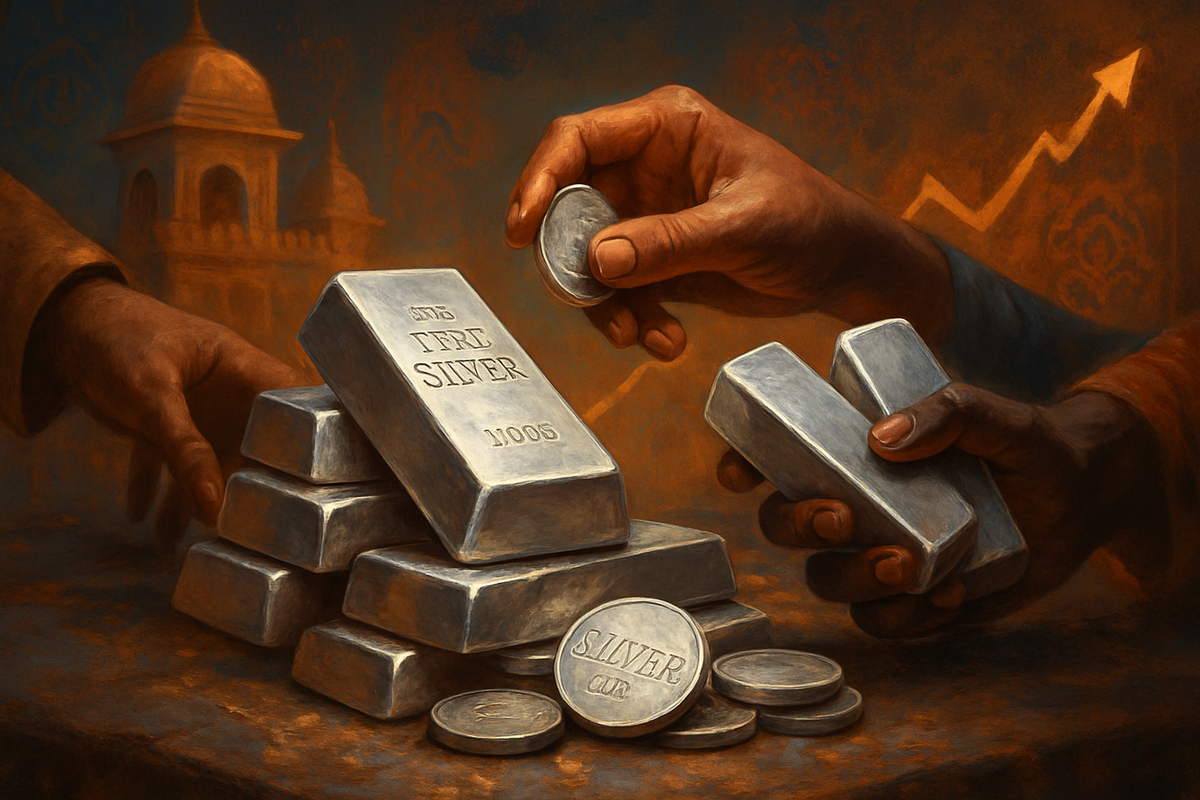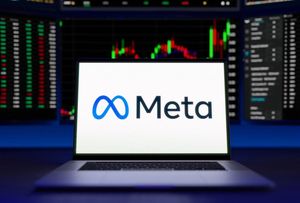
The Indian silver market has been gripped by an unprecedented "silver squeeze" in October 2025, sending prices to historic highs and creating severe physical shortages. This crisis, fueled by a unique blend of festive demand, speculative buying, and a constrained global supply, has had immediate and significant implications, not only within India but also across international bullion markets. The traditional festive season of Dhanteras and Diwali has ignited a buying frenzy, pushing domestic silver prices to record levels, with physical market premiums skyrocketing and global ripple effects causing scarcity even in major bullion hubs.
Unpacking the Silver Squeeze: A Deep Dive into Market Chaos
The silver squeeze in India during October 2025 emerged as a perfect storm of factors, culminating in a dramatic surge in demand that far outstripped available supply. By mid-October, domestic silver prices in cities like Chennai and Hyderabad reportedly hit an astonishing ₹190,000 per kilogram, while the Multi Commodity Exchange (MCX) December 2025 futures contract also reached an all-time high of ₹170,415 per kilogram. This domestic fervor quickly translated to the global stage, with international silver prices briefly surpassing $54 an ounce.
The timeline leading to this moment was characterized by a confluence of events. For several years, the global silver market had been operating in a deficit, with demand consistently outstripping supply since 2021, depleting surplus stocks by an estimated 678 million ounces. This underlying scarcity was exacerbated by a significant decline in India's silver imports, which plunged by 42% to 3,302 tons between January and August 2025, even as investor interest grew. As October's festive season approached, a crucial shift in Indian consumer behavior became apparent: with gold prices also at record highs, millions of buyers, traditionally favoring gold, turned to silver as a more accessible precious metal for auspicious purchases and investment. This was further amplified by social media influencers, such as investment banker Sarthak Ahuja, who promoted silver as the "next big buy," creating a widespread "Fear Of Missing Out" (FOMO) among investors.
Key players and stakeholders involved in this squeeze included major Indian refineries like MMTC-Pamp, which, for the first time in its history, reported running out of silver stock. Bullion dealers across the country faced complete sell-outs, with reports of bidding wars in Mumbai as buyers prioritized availability over cost. Globally, major suppliers like JPMorgan Chase & Co. (NYSE: JPM) informed clients of no immediate availability for delivery to India, indicating the depth of the physical shortage. The London silver market, the global benchmark, also reportedly experienced a severe lack of available metal, with borrowing costs for silver briefly soaring to annualized rates of 200%.
Initial market reactions were swift and dramatic. Premiums for physical silver in India surged from a few cents to over $5 an ounce, and in some cases, reached as high as 10% above global rates. Indian silver Exchange-Traded Funds (ETFs) were compelled to suspend new subscriptions due to their inability to acquire physical silver to back new investments. After the initial peak, the market experienced extreme volatility, with both international and domestic prices tumbling by 6-7% in a sudden correction, underscoring the speculative nature and fragility of the market during the squeeze.
Companies Navigating the Silver Squeeze: Winners and Losers
The unprecedented silver squeeze in India during October 2025 has created a bifurcated landscape for public companies, with some poised to gain significantly from soaring prices while others grapple with severe supply disruptions and escalating costs. The ripple effects are being felt across the entire silver supply chain, from primary producers to industrial consumers and financial institutions.
The Beneficiaries: Mining and Primary Producers
Companies involved in silver mining, particularly those with substantial production capacities, stand to be the primary beneficiaries of the price surge. Higher spot prices directly translate into increased revenue and potentially fatter profit margins, assuming their operational costs remain relatively stable.
- Hindustan Zinc Ltd (NSE: HINDZINC), a subsidiary of Vedanta Limited, emerges as a clear winner. As India's largest integrated producer of zinc, lead, and silver, and ranking among the top five global silver producers, HZL is uniquely positioned. Its Sindesar Khurd mine in Rajasthan is a significant silver asset. The company is poised for increased earnings due to the higher silver prices, which directly boost its top and bottom lines.
- Vedanta Ltd (NSE: VEDL), as the parent company with a majority stake in Hindustan Zinc, indirectly benefits from HZL's enhanced profitability. Vedanta, a diversified natural resources conglomerate, sees its overall financial health bolstered by the strong performance of its silver-producing arm.
These mining companies could also see enhanced incentives for exploration and expansion of existing production capacities in the long term, securing future supply and market share. Investor sentiment often turns bullish on such stocks during commodity price surges, potentially leading to higher stock valuations.
The Challengers: Refiners, Industrial Users, and Financial Institutions
Conversely, the severe physical shortage and extreme price volatility have created significant headwinds for refiners, industrial users, and certain financial institutions.
- Refiners and Bullion Dealers: Companies like MMTC-Pamp India Pvt, India's largest precious metals refinery, faced unprecedented challenges, reportedly running out of silver stock for the first time. Similarly, Hindustan Platinum, a prominent refiner, would likely contend with difficulties in sourcing adequate raw silver. While demand for their refined products is high, the inability to procure raw material leads to missed sales opportunities, operational strain, and potential reputational damage.
- Industrial Users: Industries heavily reliant on silver as a raw material face significantly higher input costs, threatening to erode profit margins if these costs cannot be passed on. This includes:
- Electronics Manufacturers: Companies producing circuit boards and electrical contacts will see their component costs rise.
- Solar Panel Manufacturers: The booming solar photovoltaic (PV) industry, a major silver consumer, faces increased production expenses.
- Electric Vehicle (EV) Manufacturers: EVs utilize silver in various electronic components, leading to higher manufacturing costs.
- Jewelry Manufacturers and Retailers: Firms like Goldiam International Ltd (NSE: GOLDIAM) and Thangamayil Jewellery Ltd (NSE: THANGAMAYL), which design and sell silver jewelry, will contend with inflated raw material costs. This could either squeeze their margins or force them to raise prices, potentially impacting consumer demand, especially outside the festive season.
- Financial Institutions and ETF Providers: The squeeze created operational complexities for those offering silver-backed investment products.
- Mutual Fund Houses such as Axis Mutual Fund (NSE: AXISBANK) and Tata Mutual Fund (NSE: TATAMOTORS) were compelled to suspend fresh investments into their Silver Exchange Traded Fund (ETF) Fund of Funds (FoFs) due to the severe supply crunch.
- Silver ETF Providers like ICICI Prudential Silver ETF (NSE: ICICISILV) and Nippon India Silver ETF (NSE: NIPPONIND) faced challenges in acquiring physical silver to back new units, despite some seeing their prices fall even amidst surging physical premiums.
- Commodity Traders like JPMorgan Chase & Co. (NYSE: JPM), a major global bullion supplier, faced difficulties in delivering silver to India, highlighting the strain on global supply chains and their ability to serve clients.
While mining companies celebrate a surge in valuations, other segments of the market are bracing for sustained challenges, adapting to a landscape of high costs and unpredictable supply.
Wider Significance: Reshaping Global Silver Dynamics
The "silver squeeze" in India during October 2025 is far more than a localized market event; it represents a critical juncture that underscores evolving global commodity dynamics and silver's increasingly pivotal role. This crisis fits into several broader industry trends, revealing potential ripple effects across various sectors and prompting closer scrutiny from regulatory bodies.
Broader Industry Trends and Silver's Evolving Role
This event vividly highlights India's increasing influence in global commodity markets. As one of the world's largest consumers and importers of silver, India's regional demand patterns, particularly during its intense festive seasons, are now demonstrably capable of acting as a "swing factor" that profoundly impacts global pricing. This signifies a shift in precious metal price discovery, with Eastern markets gaining greater sway.
The squeeze also emphasizes silver's unique dual demand dynamics. It serves as both a traditional monetary precious metal—a safe haven and investment vehicle—and an indispensable industrial commodity, critical for burgeoning green technologies like solar panels, as well as electronics and medical applications. This dual role amplifies price volatility and market sensitivity to both economic sentiment and technological advancements. The persistent structural supply deficits in the global silver market, driven by limited mine production and silver often being a byproduct of other metal mining, make the market inherently vulnerable to such demand shocks. This structural imbalance suggests that periods of market tightness could become more frequent.
Furthermore, the role of social media hype in encouraging Indian buyers to pivot from gold to silver for Diwali points to a broader trend of retail and social media influence in commodity markets, echoing phenomena previously observed in equity markets.
Ripple Effects Across Competitors and Partners
The implications of this squeeze extend throughout the global supply chain:
- Suppliers and Mining Companies: Nations and companies that supply silver bullion, such as those in Australia, Mexico, Peru, and China, will likely experience sustained heightened demand and potentially elevated prices for their exports. The inability of major global bullion banks like JPMorgan Chase & Co. (NYSE: JPM) to meet Indian demand underscores the significant strain across the global supply chain. Silver mining companies globally are poised to benefit from improved profit margins due to elevated prices.
- Industrial Users: Industries heavily reliant on silver, including solar panel manufacturers, electronics producers, and medical device companies, face increased raw material costs. This could lead to higher production costs, potential delays, or even incentivize innovation in silver-saving technologies and the exploration of alternative materials to mitigate future supply risks.
- Jewelry and Silverware Markets: India, being the world's largest silverware market, will see its manufacturers grappling with higher input costs. This could translate to higher retail prices for silver jewelry and articles, potentially impacting consumer purchasing behavior or leading to demand destruction in the long run.
- Investment Products and Funds: While Indian silver ETFs initially saw massive inflows, the subsequent price correction and operational hurdles (like suspending new subscriptions) introduce volatility and complexity. This might prompt a re-evaluation of risk management strategies for both institutional and individual investors in silver-backed financial products globally.
Regulatory and Policy Implications
The October 2025 silver squeeze is likely to trigger significant attention from regulators, both in India and internationally:
- Enhanced Regulatory Scrutiny in India: India's markets regulator, SEBI, which has already emphasized strengthening commodity markets, may accelerate efforts to boost institutional participation and develop robust regulatory frameworks. This could lead to increased oversight of commodity trading, improved transparency in inventory reporting, and measures to manage speculative activity.
- Review of ETF Structures: The substantial volume of physical silver locked away by ETFs and the temporary restrictions on new ETF account openings in India may prompt regulators to review the structure and impact of physically-backed ETFs on available spot supply and market liquidity.
- Trade Policy Impact: Concerns about potential tariffs on critical minerals underscore how national trade policies can exacerbate commodity market squeezes. This could reignite discussions on the strategic importance of certain commodities and the stability of their supply chains.
- International Coordination: The global nature of the squeeze, impacting markets from India to London and the Comex, could lead to calls for greater international cooperation among regulatory bodies to ensure market stability and prevent manipulation.
Historical Precedents and Key Distinctions
The 2025 India silver squeeze bears some resemblance to historical events, most notably the Hunt Brothers Silver Squeeze of 1979-1980, which sent prices soaring before a dramatic collapse. However, a key distinction is that the current event is largely seen as a convergence of fundamental demand and supply factors, rather than a single entity attempting market manipulation. The 2011 silver price spike also involved sharp swings driven by speculative interest.
Compared to other commodity squeezes, such as the nickel squeeze in March 2022, the silver event highlights the potential for extreme market stress. Crucially, unlike previous squeezes often driven by speculative paper contracts, the 2025 event is characterized by a genuine physical scarcity and a structural shift in how physical silver is held, with more metal locked away in long-term commitments and investment vehicles. This suggests that the underlying drivers of the current squeeze may be more structural and persistent, posing a unique challenge to market stability.
What Comes Next: Navigating a Transformed Silver Market
The reverberations of India's silver squeeze in October 2025 are set to reshape the silver market for years to come, demanding strategic pivots from all participants. While short-term volatility is a certainty, the long-term outlook points to a fundamental re-evaluation of silver's value and market structure.
Short-Term Volatility and Lingering Scarcity
In the immediate aftermath, extreme price volatility is expected to persist. Daily price swings of $5-$10 an ounce could become common as market liquidity remains thin and major players adjust their positions. Physical market tightness, particularly in key vaults globally, is anticipated to endure, leading to continued high premiums for physical metal in regions like India. Liquidity challenges, including wider bid-ask spreads, will likely persist as market makers adapt to this new equilibrium. Arbitrage opportunities, driven by pronounced price divergences between major trading hubs, will emerge, prompting complex logistical challenges such as air-freighting silver bars to capitalize on these differences. The intense demand from India, fueled by the Diwali festival and social media, has created a severe shortage that will take time to alleviate.
Long-Term Revaluation and Structural Shifts
Looking beyond the immediate turbulence, the silver squeeze is expected to fundamentally reset expectations for silver's valuation. Many analysts project further price increases, with some forecasting $65-$75 per ounce in the medium term (2026) and potentially higher in the future. This will solidify silver's status as a critical commodity for the green economy and a hedge against global uncertainties.
The persistent structural deficit, where industrial and investment demand consistently outpaces mine production, is a powerful long-term bullish factor. Mine production has lagged demand for several consecutive years, creating a cumulative deficit of 800 million ounces since 2021. This imbalance, coupled with constraints like limited refining capacities and long lead times for new mine supply (6-12 years), suggests sustained higher price levels compared to pre-squeeze norms. The market may also transition towards a more fragmented, regionally-focused structure, with Eastern markets like China, India, and Dubai potentially gaining increased influence in global precious metals pricing.
Strategic Pivots and Adaptations
All market participants, from miners to industrial users and investors, must implement both short-term adjustments and long-term strategic pivots:
- Industrial Users: Industries heavily reliant on silver, such as solar panel manufacturing, electronics, and electric vehicles, must prioritize securing long-term supply contracts and exploring immediate hedging solutions to mitigate cost shocks. This may also accelerate research into material substitutions and enhance recycling efforts. Re-evaluating sourcing strategies to build more diversified or localized supply chains and potentially engaging in vertical integration will be crucial for supply chain resilience.
- Investors: Investors should brace for heightened risk and employ disciplined risk management strategies. This includes diversifying through physical metals, ETFs, and mining stocks, as well as setting clear exit strategies. Understanding the differences between intrinsic value and temporary price spikes is vital. Viewing silver as a long-term monetary insurance policy, rather than a short-term trading vehicle, is a prudent approach given the potential for extreme volatility.
- Market Structure and Regulators: The "broken" state of the London silver market, marked by a severe inventory crisis and extreme lease rates, may prompt regulatory scrutiny and calls for greater transparency in commodity derivatives. Policy adjustments and trading rule updates could play a vital role in managing supply risks and ensuring market functionality.
Emerging Opportunities and Challenges
Opportunities:
- Recycling Technologies: The squeeze could accelerate investment in innovative recycling technologies to recover silver from industrial waste and end-of-life products.
- Advanced Hedging Solutions: Increased volatility will drive demand for sophisticated hedging solutions for industrial users and investors.
- Mining Companies: Silver mining companies, especially those with substantial proven reserves and efficient operations, stand to benefit immensely from soaring spot prices and improved profit margins.
- Silver-Saving Technologies: Companies developing technologies to reduce silver content in industrial applications or find substitutes could see increased demand and investment.
Challenges:
- Extreme Volatility and Illiquidity: The silver market will likely remain highly volatile, posing significant risks for traders and investors.
- Demand Destruction: If prices become unsustainably high for a prolonged period, industrial users may accelerate the search for alternatives, leading to demand destruction for silver in some applications.
- Regulatory Scrutiny: Sustained high prices and market dislocations could attract increased attention from commodity market regulators, potentially leading to new rules or interventions.
- Supply Chain Vulnerabilities: The concentrated nature of refining operations, minting constraints, and transport logistics expose the silver supply chain to bottlenecks and delays, amplifying squeeze conditions.
Potential Scenarios
Several scenarios could unfold:
- Sustained Bull Market with Volatility: The most likely scenario involves silver maintaining significantly higher price levels than historical norms, experiencing increased volatility as markets adjust to new supply-demand dynamics. This "industrial super-cycle," driven by green energy adoption and persistent deficits, could see prices gradually rise over the next 5 years.
- Soft Landing and New Equilibrium: Prices could stabilize at a new, higher equilibrium as supply gradually adjusts to demand and remaining short positions are covered without major financial market contagion.
- Disruptive Market Instability: A more disruptive scenario could involve further price spikes, potentially triggering wider instability if large financial institutions face insolvency due to their short exposures. The absence of central bank intervention in silver, unlike gold, removes a stabilizing force.
The India silver squeeze of October 2025 marks a pivotal moment, underscoring silver's unique position as both a monetary safe-haven and a critical industrial metal, with far-reaching implications for global commodity markets and investment strategies.
Wrap-Up: A New Era for Silver
The "silver squeeze" that gripped India in October 2025 serves as a potent reminder of the intricate and increasingly interconnected nature of global commodity markets. What began as a regional surge in festive demand quickly cascaded into a worldwide scramble for physical silver, exposing deep-seated vulnerabilities and fundamentally reshaping the outlook for this critical metal.
Key Takeaways from the Squeeze
The event was a perfect storm, primarily ignited by an unprecedented shift in Indian festive buying, as millions pivoted from expensive gold to more accessible silver, fueled by social media hype. This immediate surge in demand collided with already depleted global inventories, leading to physical shortages in India's largest refinery, MMTC-Pamp, and skyrocketing domestic premiums. The ripple effect was global, with supply chains strained to their breaking point, affecting major bullion hubs like London and key suppliers such as JPMorgan Chase & Co. (NYSE: JPM). While prices soared to historic highs, a sharp, albeit temporary, correction followed, underscoring the market's extreme volatility. Crucially, the squeeze highlighted underlying structural imbalances: a persistent global supply deficit, largely driven by booming industrial demand from green technologies, which had been accumulating for years.
Assessing the Market Moving Forward
In the short term, market distortions are expected to persist for several weeks to a couple of months. Once Indian imports normalize and post-festive buying subsides, domestic prices are likely to consolidate and realign with international levels. However, the long-term outlook for silver remains decidedly bullish. Analysts from firms like Motilal Oswal Financial Services Limited (MOFSL) forecast significant price increases, with COMEX silver potentially reaching $75 per ounce by 2026 and even higher in 2027. Domestically, Indian prices could soar to ₹2,40,000 per kilogram by the end of 2026. This optimism is firmly rooted in the relentless growth of industrial demand from sectors like solar energy, electric vehicles (EVs), and electronics, which now account for nearly 59% of total silver consumption. The continued global supply deficit, projected through 2027, will provide strong underlying support for higher price levels.
Significance and Lasting Impact
The October 2025 silver squeeze carries profound significance. It unequivocally exposed the fragility of the global silver supply chain and the limited "free float" of physical metal, much of which is now locked away in ETFs. More importantly, it underscored India's substantial and growing influence in global precious metals markets, demonstrating how localized cultural and investment demands can trigger international ramifications. Unlike previous speculative spikes, this rally is seen as fundamentally grounded in real-world industrial demand, suggesting a potential new, higher price floor for silver. This event marks a new paradigm, where physical market fundamentals increasingly dictate price action over purely paper-driven speculation.
What Investors Should Watch For
In the coming months, investors should closely monitor several key indicators:
- Normalization of Supply Chains: Observe the pace at which global silver imports to India stabilize and how quickly refineries can replenish their stocks.
- Post-Festive Demand Dynamics: Assess how Indian domestic demand evolves after the peak festive and wedding seasons, as this will influence local premiums.
- Industrial Demand Trends: Keep a keen eye on the growth trajectories of key industrial sectors like solar energy and EVs, as their consumption will remain a significant driver for silver prices.
- ETF Flows and Investor Sentiment: Monitor investment flows into silver ETFs globally, as large inflows can quickly absorb available physical supply and impact market sentiment.
- Global Economic Cues: Factors such as US dollar stability, inflation concerns, and broader geopolitical developments will continue to influence investor interest in silver as a hedge. The weakening Indian Rupee could further amplify local returns for Indian investors.
- Regulatory Developments: Watch for any potential regulatory changes or enhanced oversight requirements in precious metal markets, particularly in India, which could impact trading practices and compliance costs.
The silver market is entering a transformative period. While volatility may be the new normal, the underlying fundamentals suggest a compelling long-term trajectory, making silver a metal to watch closely.
This content is intended for informational purposes only and is not financial advice





